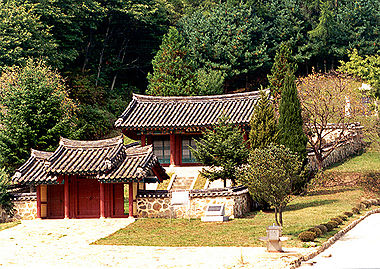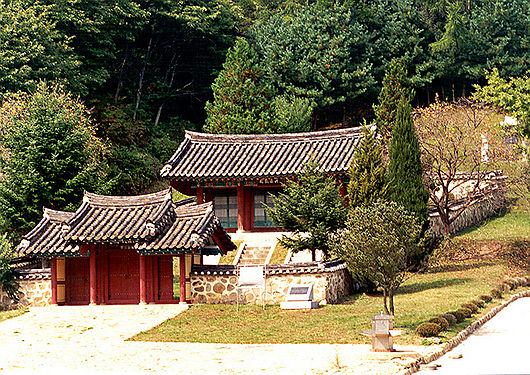"청주 신채호 사당 및 묘소"의 두 판 사이의 차이
DH 교육용 위키
| (같은 사용자에 의한 6개의 중간 편집이 숨겨짐) | |||
| 1번째 줄: | 1번째 줄: | ||
{{CHfull | {{CHfull | ||
| − | |사진 = | + | |사진 = Sinchaeho_shrine.jpg |
|지정지역 = 충청북도 | |지정지역 = 충청북도 | ||
|지정유형 = 기념물 | |지정유형 = 기념물 | ||
|지정번호 = 90 | |지정번호 = 90 | ||
| − | |지정년 = | + | |지정년 = 1993 |
| − | |지정월 = | + | |지정월 = 11 |
| − | |지정일 = | + | |지정일 = 5 |
|지정명칭 = 청주 신채호 사당 및 묘소 | |지정명칭 = 청주 신채호 사당 및 묘소 | ||
|한자명칭 = 淸州 申采浩 祠堂 및 墓所 | |한자명칭 = 淸州 申采浩 祠堂 및 墓所 | ||
|영문명칭 = Shrine and Tomb of Sin Chae-ho, Cheongju | |영문명칭 = Shrine and Tomb of Sin Chae-ho, Cheongju | ||
|분류 = 묘소 | |분류 = 묘소 | ||
| − | |세부분류 = | + | |세부분류 = 사당 |
| − | |건립제작 = | + | |건립제작 = 1960 |
| − | |건립제작세기 = | + | |건립제작세기 = 20 |
| − | |건립제작시대 = | + | |건립제작시대 = 현대 |
|소유자 = | |소유자 = | ||
| − | |관리자 = | + | |관리자 = 고령신씨종중 |
|연락처 = | |연락처 = | ||
| − | |주소도 = | + | |주소도 = 충청북도 |
| − | |주소시 = | + | |주소시 = 청주시 |
| − | |주소구 = | + | |주소구 = 상당구 |
| − | |주소면 = | + | |주소면 = 낭성면 |
| − | |주소길 = | + | |주소길 = 귀래길 |
| − | |주소번호 = | + | |주소번호 = 249 |
|주소번지 = | |주소번지 = | ||
| − | |위도 = | + | |위도 = 36.636031 |
| − | |경도 = | + | |경도 = 127.620132 |
| − | |웹사이트 = | + | |웹사이트 = http://www.cha.go.kr/korea/heritage/search/Culresult_Db_View.jsp?mc=NS_04_03_02&VdkVgwKey=23,00900000,33 |
|관계1 = | |관계1 = | ||
|관련기사1 = | |관련기사1 = | ||
| 48번째 줄: | 48번째 줄: | ||
|관계10 = | |관계10 = | ||
|관련기사10 = | |관련기사10 = | ||
| − | |국문 = 신채호 선생은 한말의 민족주의 사학자이며 언론인이요 독립 운동가이다. 호는 단재이며 본관은 고령이다. 26세에 성균관 박사를 지냈고 <황성신문>, <대한매일신보>등에 민족의식을 높이는 논설을 쓰면서 항일운동을 하였다. 1910년 중국으로 망명하여 | + | |국문 = [[신채호]] 선생은 한말의 민족주의 사학자이며 언론인이요 독립 운동가이다. 호는 단재이며 본관은 고령이다. 26세에 성균관 박사를 지냈고 <[[황성신문]]>, <[[대한매일신보]]>등에 민족의식을 높이는 논설을 쓰면서 항일운동을 하였다. 1910년 중국으로 망명하여 [[독립운동]]을 하면서 국사의 연구와 저술에 전념하다 1928년 일본경찰에게 체포되어 여순 감옥에서 복역 중 순국하였다. <[[조선상고사]]>등 많은 저술을 남기고 있다. 1962년 건국훈장 대통령장이 추서되었다. 사당은 1960년에 [[고령신씨|신씨]] 문중에서 낭성면 관정리에 세웠던 것이나, 1978년 이곳으로 옮겨 새로 정면 3칸, 측면 2칸의 [[맞배지붕집]]을 세우고 영정을 봉안하였다. 묘소는 선생이 어린 시절에 살던 옛 집터인 이곳에 단장하였다. 묘비는 [[한용운]](韓龍雲), [[오세창]](吳世昌)이 만든 것을 [[신백우]](申伯雨)가 세웠으며, 1972년에 세운 사적비가 있다. |
| − | |영문 = This is the shrine and tomb of Sin Chae-ho (1880-1936), an independence activist, historian, and journalist of the early 20th century. In the years leading up to Japan’s occupation of Korea, Sin published many patriotic articles in support of Korean sovereignty. When Korea was annexed in 1910, he left for Shanghai, where he continued his fight for independence and dedicated himself to research and writing on Korean history. Among his writings is the highly regarded book, Joseon sanggosa (Ancient History of Korea). In 1928, he was arrested by the Japanese police in Shanghai and died in prison in China. He was awarded the presidential medal of the Order of Merit for National Foundation in 1962. This shrine was first built in his hometown in 1960 by his clan, but it was moved and rebuilt here in front of his tomb in 1978 by the local government. The epitaph on the tombstone was composed and calligraphed by two independence movement leaders: Han Yong-un, a Buddhist reformer and poet, and O Se-chang, a renowned calligrapher. A stele was erected in 1972 to commemorate the construction of this historic site. | + | |영문 = This is the shrine and tomb of Sin Chae-ho (1880-1936), an independence activist, historian, and journalist of the early 20th century. In the years leading up to Japan’s occupation of Korea, Sin published many patriotic articles in support of Korean sovereignty. When Korea was annexed in 1910, he left for Shanghai, where he continued his fight for independence and dedicated himself to research and writing on Korean history. Among his writings is the highly regarded book, Joseon sanggosa (Ancient History of Korea). In 1928, he was arrested by the Japanese police in Shanghai and died in prison in China. He was awarded the presidential medal of the Order of Merit for National Foundation in 1962. This shrine was first built in his hometown in 1960 by his clan, but it was moved and rebuilt here in front of his tomb in 1978 by the local government. The epitaph on the tombstone was composed and calligraphed by two independence movement leaders: Han Yong-un, a Buddhist reformer and poet, and O Se-chang, a renowned calligrapher. A stele was erected in 1972 to commemorate the construction of this historic site. ([https://en.wikipedia.org/wiki/Shin_Chaeho More Information on Sin Chae-ho in English]) |
}} | }} | ||
==위치 Location== | ==위치 Location== | ||
| − | <googlemap width="600" height="300" lat=" | + | <googlemap width="600" height="300" lat="36.636031" lon="127.620132" type="normal" zoom="15" icon="http://maps.google.com/mapfiles/marker.png"> |
| − | + | 36.636031, 127.620132 [[{{PAGENAME}}]] | |
</googlemap> | </googlemap> | ||
==갤러리 Gallery== | ==갤러리 Gallery== | ||
| − | <gallery mode=packed-hover heights=250px | + | <gallery mode=packed-hover heights=250px> |
| − | 파일: | + | 파일:Sinchaeho.jpg|Sin Chae-ho<ref>[http://encykorea.aks.ac.kr/Contents/Index?contents_id=E0033432 한국민속문화대백화서전 '신채호']</ref> |
| − | 파일: | + | 파일:Sinchaeho_shrine.jpg|Sin Chae-ho's Shrine<ref>[http://www.cha.go.kr/korea/heritage/search/Culresult_Db_View.jsp?mc=NS_04_03_02&VdkVgwKey=23,00900000,33 문화재청 '청주 신채호 사당 및 묘소']</ref> |
| − | 파일: | + | 파일:Sinchaeho_tomb.jpg|Sin Chae-ho's Tomb<ref>[http://www.cha.go.kr/korea/heritage/search/Culresult_Db_View.jsp?mc=NS_04_03_02&VdkVgwKey=23,00900000,33 문화재청 '청주 신채호 사당 및 묘소']</ref> |
</gallery> | </gallery> | ||
==주석== | ==주석== | ||
<references/> | <references/> | ||
2016년 12월 26일 (월) 23:54 기준 최신판
| Shrine and Tomb of Sin Chae-ho, Cheongju | |
|---|---|

| |
| 지정 정보 Designation Information | |
| 번호 Number | 충청북도 기념물 제90호 |
| 지정일 Date | 1993년 11월 5일 |
| 명칭 Name | |
| 국문 Korean | 청주 신채호 사당 및 묘소 |
| 한자 Chinese | 淸州 申采浩 祠堂 및 墓所 |
| 영문 English | Shrine and Tomb of Sin Chae-ho, Cheongju |
| 세부 정보 Details | |
| 분류 Type | 묘소 / 사당 |
| 건립·제작 Creation | 현대시대 / 20 세기 / 1960년 |
| 위치 및 연락처 Location & Contact | |
| 소유자 Owner | N/A |
| 관리자 Manager | 고령신씨종중 |
| 연락처 Contact | N/A |
| 주소 Address | 충청북도 청주시 상당구 낭성면 귀래길 249 |
| 위도 Latitude | 36.636031 |
| 경도 Longitude | 127.620132 |
| 웹사이트 Website | 링크 Link |
해설문 Interpretive Text
| 국문 Korean | 영문 English |
|---|---|
| 신채호 선생은 한말의 민족주의 사학자이며 언론인이요 독립 운동가이다. 호는 단재이며 본관은 고령이다. 26세에 성균관 박사를 지냈고 <황성신문>, <대한매일신보>등에 민족의식을 높이는 논설을 쓰면서 항일운동을 하였다. 1910년 중국으로 망명하여 독립운동을 하면서 국사의 연구와 저술에 전념하다 1928년 일본경찰에게 체포되어 여순 감옥에서 복역 중 순국하였다. <조선상고사>등 많은 저술을 남기고 있다. 1962년 건국훈장 대통령장이 추서되었다. 사당은 1960년에 신씨 문중에서 낭성면 관정리에 세웠던 것이나, 1978년 이곳으로 옮겨 새로 정면 3칸, 측면 2칸의 맞배지붕집을 세우고 영정을 봉안하였다. 묘소는 선생이 어린 시절에 살던 옛 집터인 이곳에 단장하였다. 묘비는 한용운(韓龍雲), 오세창(吳世昌)이 만든 것을 신백우(申伯雨)가 세웠으며, 1972년에 세운 사적비가 있다. | This is the shrine and tomb of Sin Chae-ho (1880-1936), an independence activist, historian, and journalist of the early 20th century. In the years leading up to Japan’s occupation of Korea, Sin published many patriotic articles in support of Korean sovereignty. When Korea was annexed in 1910, he left for Shanghai, where he continued his fight for independence and dedicated himself to research and writing on Korean history. Among his writings is the highly regarded book, Joseon sanggosa (Ancient History of Korea). In 1928, he was arrested by the Japanese police in Shanghai and died in prison in China. He was awarded the presidential medal of the Order of Merit for National Foundation in 1962. This shrine was first built in his hometown in 1960 by his clan, but it was moved and rebuilt here in front of his tomb in 1978 by the local government. The epitaph on the tombstone was composed and calligraphed by two independence movement leaders: Han Yong-un, a Buddhist reformer and poet, and O Se-chang, a renowned calligrapher. A stele was erected in 1972 to commemorate the construction of this historic site. (More Information on Sin Chae-ho in English) |
관련 항목 Related Entries
| 본 기사 Current Entry | 관계 Relation | 관련 기사 Related Entry |
|---|---|---|
| 청주 신채호 사당 및 묘소 | ||
위치 Location
갤러리 Gallery
Sin Chae-ho[1]


